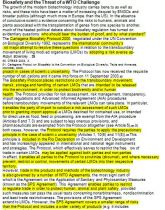Studijní materiál: The Big Chill: The WTO and Multilateral Environmental Agreements
Skrýt detaily | Oblíbený- Kvalita:89,2 %
- Typ:Studijní materiál
- Univerzita:Univerzita Karlova v Praze
- Fakulta:Fakulta sociálních věd
- Kategorie:Humanitní vědy
- Podkategorie:Politologie
- Předmět:Teorie mezinárodních vztahů
- Autor:clean.bandit
- Ročník:3. ročník
- Rozsah A4:21 strán
- Zobrazeno:1 258 x
- Stažené:0 x
- Velikost:0,2 MB
- Formát a přípona:MS Office Word (.doc)
- Jazyk:anglický
- ID projektu:9401
- Poslední úprava:16.01.2017
Robyn Eckersley
If sustainable development is about the integration of economic and environmental goals, then there seems to be a signi.cant lack of integration between the preeminent global governance structures set up to manage trade and environment respectively.
The international trade regime has evolved into one of the most powerful and inuential multilateral regimes in the world today in terms of its ability to attract members (with the lure of expanding markets) and discipline them. The legal norms in the World Trade Organization’s (WTO) trade agreements are backed up by powerful sanctions (which include trade retaliation) and a sophisticated dispute resolution mechanism accompanied by a rapidly developing jurisprudence that is unequalled in other international regimes. In contrast, multilateral environmental agreements (MEAs), and international environmental law generally, provide a more fragmented form of governance that lacks the coherence, reach, .nancial backing and organizational structure of the WTO.1 Most MEAs typically work in accordance with the voluntarist tradition of international law and proceed on an ad hoc, issue-byissue basis by inducing cooperation and generally avoiding punitive sanctions and courts.2 Judged in terms of size and teeth, we might regard the WTO as a large tiger and MEAs as a ragged collection of small cats. The irony is that in the one area where certain MEAs do possess effective sanctions (i.e. trade restriction), they remain vulnerable to legal challenge in the WTO.
If sustainable development is about the integration of economic and environmental goals, then there seems to be a signi.cant lack of integration between the preeminent global governance structures set up to manage trade and environment respectively.
The international trade regime has evolved into one of the most powerful and inuential multilateral regimes in the world today in terms of its ability to attract members (with the lure of expanding markets) and discipline them. The legal norms in the World Trade Organization’s (WTO) trade agreements are backed up by powerful sanctions (which include trade retaliation) and a sophisticated dispute resolution mechanism accompanied by a rapidly developing jurisprudence that is unequalled in other international regimes. In contrast, multilateral environmental agreements (MEAs), and international environmental law generally, provide a more fragmented form of governance that lacks the coherence, reach, .nancial backing and organizational structure of the WTO.1 Most MEAs typically work in accordance with the voluntarist tradition of international law and proceed on an ad hoc, issue-byissue basis by inducing cooperation and generally avoiding punitive sanctions and courts.2 Judged in terms of size and teeth, we might regard the WTO as a large tiger and MEAs as a ragged collection of small cats. The irony is that in the one area where certain MEAs do possess effective sanctions (i.e. trade restriction), they remain vulnerable to legal challenge in the WTO.


